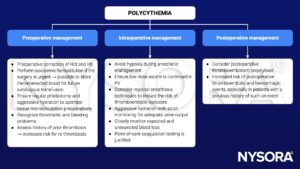Learning objectives
- Define polycythemia
- Describe the classification of polycythemia
- Anesthetic management of a patient with polycythemia
Definition and mechanisms
- Polycythemia or erythrocytosis is an increase in red blood cell mass, and is associated with an increase in hemoglobin concentration (Hb) and hematocrit (Hct)
- The condition increases blood viscosity and can reduce cerebral blood flow
Classification
- Absolute polycythemia (increased red cell mass)
- Primary (polycythemia vera; PV)
- Secondary
- Idiopathic
- Apparent polycythemia (normal red cell mass)
- Reduced plasma volume
Primary polycythemia
- PV is characterized by the clonal proliferation of myeloid cells
- >95% of patients have a genetic mutation of JAK2 → stimulates overproduction of erythrocytes, platelets, and granulocytes
- JAK2 mutation is not specific for PV, also found in patients with primary thrombocytosis and primary myelofibrosis
- Clinical manifestations result from thrombotic episodes secondary to increased blood viscosity
- Production of immature platelets with variable function and acquired von Willebrand’s disease (vWD) are thought to be behind the bleeding tendency
- Associated laboratory findings
- Thrombocytosis
- Leukocytosis
- Elevated lactate dehydrogenase
- Clinical features
- Hypertension (46%)
- Splenomegaly (36%)
- Pruritus (36%)
- Erythromelalgia (29%)
- Arterial thrombosis (16%)
- Venous thrombosis (7%)
- Hemorrhage (4%)
- Facial plethora
- Hepatomegaly
- Gout
Secondary polycythemia
- Increased red cell mass is due to increased erythropoietin (EPO) production
- Compensatory mechanism in response to chronic tissue hypoxia or inappropriate production of EPO by the kidneys
- Causes include
- Chronic obstructive pulmonary disease (COPD)
- Obstructive sleep apnea (OSA)
- Cyanotic heart disease
- Altitude
- Renal artery stenosis
- Renal tumors
- Transplanted kidneys
Idiopathic polycythemia
- Increased red cell mass without an identifiable cause
- Patients are more commonly male and >50% present with vascular occlusive complications
Apparent polycythemia
- Reduced plasma volume results in an increased Hct and Hb on laboratory tests, but the red cell mass is normal
- Associated with the following clinical conditions
- Obesity
- Hypertension
- Smoking
- Excessive alcohol intake
- Diuretic use
Signs and symptoms
- Fatigue
- Headaches
- Dizziness
- Episodic blurred vision
- Red skin (particularly on the face, hands, and feet)
- Peripheral tingling, or burning and itching
- Hypertension
- Mucosal cyanosis
- Bruising
- Petechiae
- Unusual bleeding, nosebleeds
- Enlarged spleen or liver
Complications
- Pulmonary embolism
- Deep vein thrombosis
- Increased risk of heart attack and stroke
Diagnosis
| Measurement | Male | Female |
|---|---|---|
| Hemoglobin (g/L) | >185 | >165 |
| Hematocrit | >0.52 | >0.48 |
Treatment
| Classification | Treatment |
|---|---|
| Primary polycythemia | Reduce the risk of thrombosis, hemorrhage, and transformation to acute leukemia or myelofibrosis Phlebotomy or venesection (Hct <0.45) and aspirin Consider hydroxyurea or interferon alpha if the above treatments fail |
| Secondary polycythemia | Phlebotomy and management of the underlying condition (if possible) |
| Idiopathic polycythemia | Phlebotomy, cytoreductive therapy is contraindicated |
| Apparent polycythemia | Lifestyle modification and phlebotomy (if required) |
Management

Suggested reading
- Pollard BJ, Kitchen G. Handbook of Clinical Anaesthesia. 4th ed. Taylor & Francis group; 2018. Chapter 7 The blood, Duncan A.
We would love to hear from you. If you should detect any errors, email us customerservice@nysora.com

